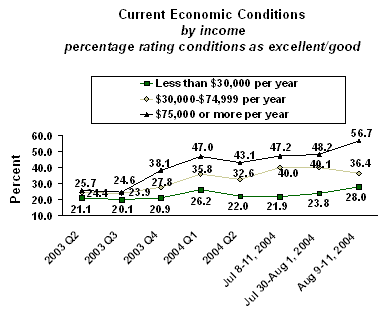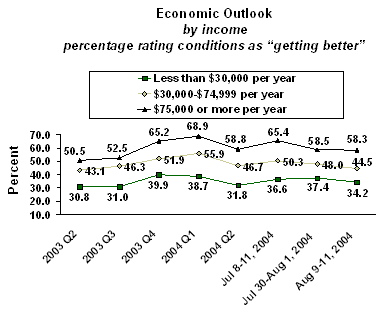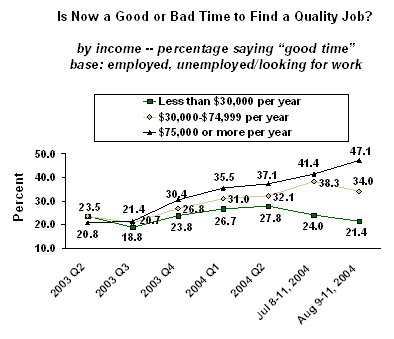GALLUP NEWS SERVICE
PRINCETON, NJ -- New Gallup Poll economic data show consumer confidence declining in mid-August. While the percentage of Americans rating current economic conditions as "good" or "excellent" remains essentially unchanged, the percentage saying now is a "good time" to find a quality job has declined, and the percentage of consumers saying the economy is "getting better" has fallen to its lowest level since May.
More importantly, consumers in different income groups continue to see significantly different economies. Higher-income consumers are not only more optimistic than are other consumers about current economic conditions, but also about the overall direction of the economy, and the availability of quality jobs.
What does all this imply about Fed Chairman Alan Greenspan's so-called "soft patch" -- the recent softness in consumer spending? Does the continued optimism of higher-income consumers suggest that this softness will be short-lived? And what does it imply for the president's economic job approval?
Higher-Income Consumers Are More Positive About Economic Conditions
Right now, according to the Aug. 9-11 survey, slightly more consumers (39%) rate current economic conditions as "good" or "excellent" than did so in mid-July (37%) or at the end of the month (38%). However, there continue to be huge differences by income. Fifty-seven percent of higher-income consumers -- those making $75,000 or more annually -- rate current economic conditions as "good" or "excellent," while 36% of middle-income consumers, making at least $30,000 but less than $75,000 annually, provide such ratings. Only 28% of lower-income consumers -- those making less than $30,000 annually -- rate current economic conditions as "good" or "excellent."
All consumer groups provide higher ratings now than they did during the second quarter. Higher-income consumers have seen the biggest improvement; their ratings have increased 14 percentage points. Middle-income consumers have seen the least improvement -- up only 3 percentage points. Lower-income consumer ratings increased 6 percentage points over the same period.

Higher-Income Consumers Are More Optimistic About the Economy's Direction
In August, just about as many consumers say economic conditions are "getting better" (45%) as say they are "getting worse" (46%). Once again, higher-income consumers are much more optimistic than are other consumers. Fifty-eight percent of higher-income consumers feel things are "getting better," while 45% of middle-income consumers and 34% of lower-income consumers feel the same way.

Higher-Income Consumers Are More Optimistic About Jobs
Currently, one in three consumers say that now is a good time to find a quality job -- down three percentage points from July. As is true for both of the other measures, higher-income consumers are much more optimistic than other consumers. Forty-seven percent of higher-income consumers say this is a good time to find a quality job -- up 10 percentage points from the second quarter. Thirty-four percent of middle-income consumers hold the same opinion -- up 2 percentage points -- while 21% of lower-income consumers agree -- down 7 percentage points from the second quarter.

Bridging the "Soft Patch"
During his report to Congress last month, Chairman Greenspan noted that the recent softness in consumer spending should prove short-lived. He went on to say, "Despite the softness of recent retail sales, the combination of higher current and anticipated future income, strengthened balance sheets, and still-low interest rates bodes well for consumer spending."
Gallup's consumer-confidence and job-market numbers don't seem to support the chairman's optimism, particularly as far as low- and moderate-income consumers are concerned. Nor do Gallup's August consumer spending intentions data. After surging to a net of +10 percentage points in early July, net consumer spending intentions -- the percentage saying they will increase spending over the next six months minus the percentage expecting their spending to decrease -- fell to just +1 percentage point in August.
Given the obvious lack of confidence among consumers in mid-August, it should not be surprising that only 46% of the public approves of the way President Bush is handling the economy, while 51% disapprove. If, as current Gallup data suggest, the "soft patch" in consumer spending turns out to be more than a short-lived phenomenon, then the president's approval in the area of the economy is likely to get worse before it gets better.
Survey Methods
Results are based on telephone interviews with 1,017 national adults, aged 18 and older, conducted Aug. 9-11, 2004. For results based on this total sample, one can say with 95% confidence that the margin of sampling error is ±3 percentage points. In addition to sampling error, question wording and practical difficulties in conducting surveys can introduce error or bias into the findings of public opinion polls.
